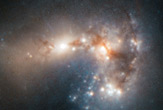Star Birth Frenzy Revealed in New Photo

A frenzy of star birth has been captured in a new photo of a distant but extremely bright galaxy.
In the photo, stars in the Haro 11 galaxy are seen clumped together in more than 200 separate groups are seen hatching at a "monumental rate," one which converts the equivalent to 20 times the mass of the sun into new stars each year, astronomers with the European Southern Observatory said in a statement. [New Haro 11 galaxy photo.]
The astronomers created the new image by combining data from the ESO Very Large Telescope and the Hubble Space Telescope operated by NASA and the European Space Agency.
Haro 11 is the second-closest Haro-type galaxy to Earth and is located 300 million light-years away.
Haro galaxies, named after astronomer Guillermo Haro (who discovered them in 1956), are those that emit unusually intense blue and violet light, which typically indicate a density of newborn stars or busy region known as an active galactic nucleus.
Haro 11 is known as a starburst galaxy, one which is undergoing intense star formation. It has been around for about 40 million years, but only began to peak in its birth of star clusters 3.5 million years ago.
The research is detailed in a recent issue of the Monthly Notices of the Royal Astronomical Society.
Get the world’s most fascinating discoveries delivered straight to your inbox.
"With such an extremely young cluster population, Haro 11 represents a unique opportunity to investigate the youngest phase of the cluster formation process and evolution in starburst systems," the astronomers wrote in their study.
Most of the very young, massive stars in Haro 11 are less than 10 million years old. The high luminosity of the stars in the infrared (beyond red visible light) part of the spectrum has led astronomers to believe they have been caught while still emerging from their cloudy cocoons or birth sites.
From this, astronomers deduced that Haro 11 is the result of the galactic merger between a young, gas-rich galaxy and an older, star-rich one.
- Hubble Photos: When Galaxies Collide
- Images: Amazing Galaxies
- Huge Star Burns Fast and Furious in Photo


